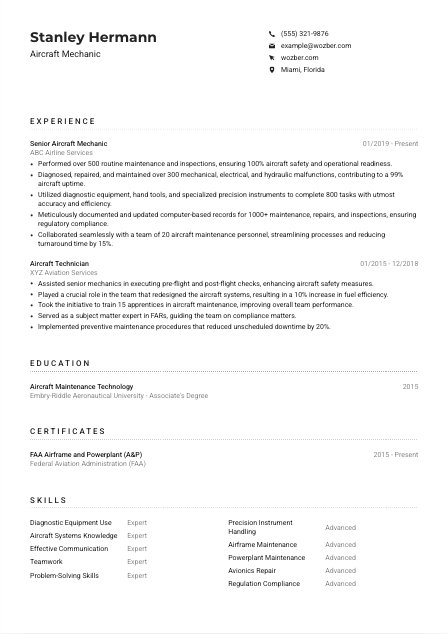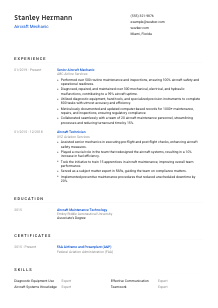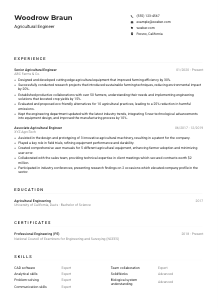Aircraft Mechanic CV Example
Fine-tuning warbirds, but your CV still can't take off? Fly into this Aircraft Mechanic CV example, turbocharged with Wozber free CV builder. Discover how you can sync your high-skies maintenance expertise with job demands, making your career trajectory as smooth as a sky set for landing!

How to write an Aircraft Mechanic CV?
Greetings, aspiring Aircraft Mechanic! In the sky-high realm of job seeking, standing out is your mission-critical objective. Your CV is not just a document; it's the ticket to your dream job at 40,000 feet. Powered by the Wozber free CV builder, this guide is your co-pilot to drafting a CV that lands as smoothly as a well-maintained aircraft. Ready for takeoff? Let's navigate through the clouds of doubt and touch down on the runway of your next career milestone.
Personal Details
Think of the Personal Details section as your flight manifest. It's your initial handshake from the cockpit, ensuring you've got clearance for takeoff with potential employers. So, let's prep your manifest to be clear and aligned with the Aircraft Mechanic position waiting for you.
1. Branding Your Name
Your name is your tail number, unique to you. Make it prominent with a clear font that commands attention, symbolizing the first beacon in the night sky.
2. Your Title: Cleared for Takeoff
Sync your job title precisely with the role you're applying for. By placing "Aircraft Mechanic" right under your name, you're signaling air traffic control (read: hiring managers) exactly which runway you're aiming for.
3. Essential Contact Coordinates
Your contact info is your beacon frequency. Make sure your phone number is free of static (typos) and your email address reads like a professional call sign. Something straightforward like firstname.lastname@email.com ensures clear communication.
4. Positioning for Landing
The job demands a local in Miami, Florida. Mentioning your Miami base in your CV isn't just geographical; it shows you're already in the hangar ready for work, no relocation turbulence expected.
5. Communication Channels
Including a LinkedIn profile or personal website can showcase a digital hangar of your past achievements and certifications. Make sure they're service-ready and align with your CV's flight plan.
Takeaway
Ensuring your Personal Details section is professionally tailored and jet-set for the Aircraft Mechanic role sets the stage for a smooth journey through the recruitment stratosphere. Consider this section your business-class lounge: exclusive, polished, and ready for boarding.





Experience
In the Experience hangar, you store your proven track record of aircraft maintenance excellence. This is where you unveil your dedication to aircraft safety and show you're no stranger to the maintenance runway. Let's get your experience ready for the clearance to advance.
- Performed over 500 routine maintenance and inspections, ensuring 100% aircraft safety and operational readiness.
- Diagnosed, repaired, and maintained over 300 mechanical, electrical, and hydraulic malfunctions, contributing to a 99% aircraft uptime.
- Utilized diagnostic equipment, hand tools, and specialized precision instruments to complete 800 tasks with utmost accuracy and efficiency.
- Meticulously documented and updated computer‑based records for 1000+ maintenance, repairs, and inspections, ensuring regulatory compliance.
- Collaborated seamlessly with a team of 20 aircraft maintenance personnel, streamlining processes and reducing turnaround time by 15%.
- Assisted senior mechanics in executing pre‑flight and post‑flight checks, enhancing aircraft safety measures.
- Played a crucial role in the team that redesigned the aircraft systems, resulting in a 10% increase in fuel efficiency.
- Took the initiative to train 15 apprentices in aircraft maintenance, improving overall team performance.
- Served as a subject matter expert in FARs, guiding the team on compliance matters.
- Implemented preventive maintenance procedures that reduced unscheduled downtime by 20%.
1. Job Description Radar
Scan the job description like you're checking for air traffic. Each requirement is a waypoint on your flight map. Your goal is to navigate through each, ensuring your CV's flight path aligns perfectly.
2. Logbook Format
Organize your experience like a well-maintained logbook. Start with your most recent flight (role), including the company as your airline, and the dates as your flight duration. This ensures your logbook tells a cohesive story of your career trajectory.
3. Mission Highlights
For each role, showcase your successful missions. Whether it's "Performed over 500 routine maintenance checks" or "Diagnosed and repaired over 300 electrical malfunctions," these are the tales of your victories in the skies.
4. Instrumentation of Achievement
Quantifying accomplishments gives them altitude. Saying you enhanced aircraft safety by 100% or reduced turnaround time by 15% adds gravity to your achievements, making your contributions tangible and impressive.
5. Relevance and Precision
Stay on course by focusing on the tasks and accomplishments that directly relate to the Aircraft Mechanic role. While being a great team player is a plus, it's your hands-on experience with aircraft that will have hiring managers ready for takeoff.
Takeaway
Your experience section is your flight history—it showcases where you've been and the quests you've conquered. Adjust your altitude to match the role you're applying for, ensuring each bullet point illustrates how indispensable you are to the aviation world. Now's the time to fly high on your past successes.
Education
Even the most seasoned Aircraft Mechanic started with the basics. Your education section is the foundation of your aviation career, showcasing the ground school where you began crafting your skills. Let's ensure this section is built to FAA standards.
1. Education Radar Check
First, identify what radar blips (educational requirements) the job listing is broadcasting. No specific degrees mentioned? Then you're clear to articulate any aviation-maintenance-related education proudly.
2. Clear Formatting Flight Path
Maintain your education section with a clean, clear structure. List each level of education as a separate flight, with your field of study, certification, and graduation year as your departure details.
3. Tailored Degree Detail
If your trajectory includes a degree relevant to aircraft maintenance, it's like having a direct flight to the interviewer's interests. Make sure your degree in Aircraft Maintenance Technology, for example, is in first class on your CV.
4. Supporting Courses as Cargo
Supplementary courses can serve as valuable cargo, adding weight to your application. Anything from avionics workshops to safety regulation seminars can increase your market value, so don't forget to list them.
5. Achievements: Your Tailwind
Any honors, clubs, or additional achievements offer a helpful tailwind to your application. Particularly if they resonate with the aircraft mechanic role, they demonstrate your passion and effectiveness in the field.
Takeaway
Your education section is your career's launching pad. Craft it to showcase the strong foundation you've built and how it's positioned you for success in the Aircraft Mechanic role. Remember, every credential is a signal to employers of your commitment to flying high in your career.
Certificates
In the world of Aircraft Mechanics, certifications are like your personal airworthiness directives—they prove you're equipped and ready for the job. Here's how to ensure your certificates section is in check and ready for inspection.
1. Essential Certifications
The job description specifically mentions the FAA Airframe and Powerplant (A&P) certification. This is a must-have. Make it the headline of your certificates section, showing you're already equipped with the key certification they're looking for.
2. Selective Listing
In aviation, precision is everything. List only those certificates directly relevant to the Aircraft Mechanic role. It's better to be an expert in relevant fields than a jack-of-all-trades with unrelated certifications.
3. Dates on Radar
Provide dates for your certifications, especially if they're recent or require renewal. This indicates to hiring managers that your knowledge is current and you're committed to staying up-to-date with industry standards.
4. Continuous Learning
Aviation technology evolves, and so should you. Regularly refreshing your certifications and picking up new ones demonstrates a continuous commitment to excellence and safety in aircraft maintenance, a quality that's highly valued in this field.
Takeaway
Your certification section is your paperwork cleared for takeoff. It's proof of your readiness and capability to handle the responsibilities of an Aircraft Mechanic. Keep it current, relevant, and directly aligned with the role's expectations to show you're always flight-ready.
Skills
In your toolbox of skills, it's the specialized wrenches and gauges—your unique skills—that make all the difference. For an Aircraft Mechanic, it's not just about knowing your tools but having the right ones for the job. Let's make sure your skills section is engineered to impress.
1. Deciphering the Blueprint
Take a close look at the job description. It's your blueprint, outlining exactly what tools (skills) you need in your toolkit. From diagnostic equipment expertise to a solid grasp of FARs, every skill listed is a part of your mission requirements.
2. Tools for the Job
List the skills that match up with the job description directly, like "Diagnostic Equipment Use" and "Aircraft Systems Knowledge." Ensure these skills are clearly visible in your tools section, as they are the ones that will get you in the door.
3. Organized Toolkit
An Aircraft Mechanic knows the importance of a well-organized tool chest. Similarly, your skills section should be clean and easy to scan, focusing on what's most important for the role you're targeting. Replace any skill that doesn't directly apply with one that does.
Takeaway
Your skills section is the first place a hiring manager looks to see if you've got the right tools for the job. Think of it as your personal inventory list, proudly showcasing the tools you wield with precision and expertise. Keep it relevant, keep it sharp, and make sure it demonstrates why you're the best Aircraft Mechanic for the role.
Languages
In the global airspace of the aviation industry, the ability to communicate in multiple languages can be your navigation system, guiding you through international territories and enhancing safety and efficiency. Let's tune your CV's language section to broadcast your linguistic capabilities.
1. Communication Frequencies
The job description highlighted English proficiency as a requirement. Thus, your proficiency in English should be loud and clear, like a confident radio call. But don't stop there if you've got more frequencies in your communication radio.
2. Essential Signals
List your language capabilities beginning with English, and categorize your proficiency honestly. Whether you're "Native" or "Fluent," show that you can communicate with clarity and precision, both critically important in aviation.
3. Additional Frequencies
If you can communicate in other languages, let them be known—especially if they're relevant to the company's operations. It's like having additional navigation aids that can prove invaluable in international contexts.
4. Signal Strength
Be honest about your language proficiency. Consider it like signal strength: "Native" means you have a clear, strong signal in that language, whereas "Basic" might mean you're still tuning into that frequency but can understand basic commands and instructions.
5. Global Navigation
Consider the scope of the Aircraft Mechanic role. If you're likely to interact with international colleagues or documentation, your multilingual skills are not just a bonus; they're an essential part of your toolkit, helping navigate global skies more effectively.
Takeaway
Your ability to communicate in multiple languages can significantly amplify your appeal as an Aircraft Mechanic candidate, much like a versatile multi-tool. Whether it's reading maintenance manuals in another language or coordinating with international teams, your linguistic skills are a testament to your readiness to operate in a global field. Embrace this aspect of your professional identity and let it shine on your CV.
Summary
The Summary section is your takeoff clearance—it gives a quick snapshot of your journey so far and why you're destined for the Aircraft Mechanic role. A well-crafted summary can elevate your CV from the tarmac to the stratosphere. Let's ensure your summary makes an unforgettable first impression.
1. Charting the Course
Digest the essence of the job posting to get a clear heading. Understand what makes an Aircraft Mechanic indispensable and how your journey aligns with that vision.
2. Introductory Coordinates
Begin with a crisp, engaging introduction that encapsulates your professional identity. "Aircraft Mechanic with over 6 years in the aviation industry" immediately establishes your experience level and area of expertise.
3. Highlighting the Flight Plan
Zoom in on key skills and experiences that directly address the job requirements. From your adeptness with diagnostic equipment to your comprehensive understanding of aircraft systems, make sure these focal points are clearly plotted.
4. A Concise Flight Log
Keep your summary focused and to the point. Aim for a smooth altitude of 3-5 lines, ensuring each word adds to the lift, propelling the hiring manager's interest to cruising levels.
Takeaway
Your summary is the runway to your CV, setting the stage for a successful liftoff. By tailoring it to lift directly off from the job description, you create a flight path that leads straight to an interview. Let your career achievements and skills soar here, previewing the expertise you'll bring to the Aircraft Mechanic role. Ready for takeoff?
Launching Your Aircraft Mechanic Journey
Congratulations, you've now completed your pre-flight checks and your CV is cleared for departure. Armed with these insights and the power of Wozber's free CV builder, including our ATS-friendly CV templates and ATS CV scanner, you're set to embark on the journey towards your next Aircraft Mechanic role. Your CV is your flight log, detailing a career journey that's both skilled and ready for new challenges. Adjust your altimeter, check your coordinates, and prepare for an engaging career flight ahead.
The sky's not the limit—it's your playground. Fly high and make your mark!

- Minimum 5 years of hands-on experience in the maintenance and repair of aircraft, with expertise in specific areas such as airframe, powerplant, or avionics.
- FAA Airframe and Powerplant (A&P) certification is required.
- Proficiency in using diagnostic equipment, hand tools, and specialized precision instruments.
- Solid understanding of aircraft systems, structures, and regulations such as Federal Aviation Regulations (FARs).
- Effective communication, teamwork, and problem-solving skills.
- Ability to effectively communicate in English is a prerequisite.
- Must be located in Miami, Florida.
- Perform routine maintenance and inspections, including pre-flight and post-flight checks, to ensure aircraft safety and operational readiness.
- Diagnose, troubleshoot, and repair mechanical, electrical, and hydraulic malfunctions on aircraft.
- Maintain accurate records of all maintenance, repairs, and inspections performed using computer-based systems.
- Collaborate with other aircraft maintenance personnel and support staff to ensure timely maintenance and service.
- Stay updated with current aircraft technologies, maintenance practices, and industry standards through training and continuing education.















